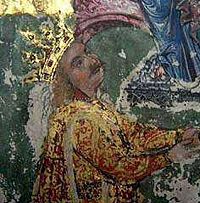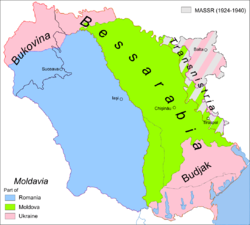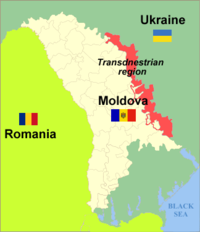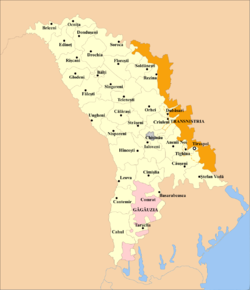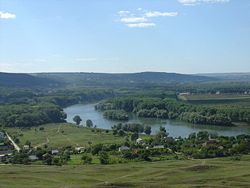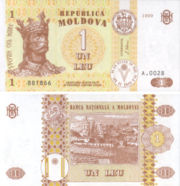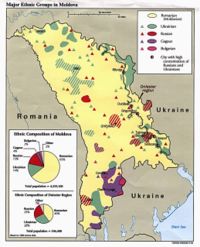Moldova
2008/9 Schools Wikipedia Selection. Related subjects: Europe; European Countries
| Republica Moldova Republic of Moldova
|
||||||
|---|---|---|---|---|---|---|
|
||||||
| Anthem: Limba noastră Our Language |
||||||
|
Location of Moldova (orange)
on the European continent (white) |
||||||
| Capital (and largest city) |
Chişinău |
|||||
| Official languages | Moldovan¹ | |||||
| Recognised regional languages | Gagauz, Russian and Ukrainian | |||||
| Demonym | Moldovan, Moldavian | |||||
| Government | Parliamentary republic | |||||
| - | President | Vladimir Voronin | ||||
| - | Prime Minister | Zinaida Greceanîi ( PCRM) | ||||
| Consolidation | ||||||
| - | Moldavian Principality | 1356 | ||||
| - | Autonomous Bessarabian Oblast | April 29, 1818 | ||||
| - | Moldavian Democratic Republic | December 16, 1917 | ||||
| - | Moldavian Soviet Socialist Republic | August 2, 1940 | ||||
| - | Independence from the Soviet Union | August 27, 1991 (Declared) December 25, 1991 (Finalized) |
||||
| Area | ||||||
| - | Total | 33,846 km² ( 139th) 13,067 sq mi |
||||
| - | Water (%) | 1.4 | ||||
| Population | ||||||
| - | 2008 estimate | 4,128,047 ( 121st2) | ||||
| - | 2004 census | 3,383,3323 | ||||
| - | Density | 121,9/km² ( 87st) 316/sq mi |
||||
| GDP ( PPP) | 2007 estimate | |||||
| - | Total | $9,367 million ( 141st) | ||||
| - | Per capita | $2,962 ( 135th) | ||||
| Gini (2007) | 37.1 (medium) | |||||
| HDI (2007) | ▲ 0.708 (medium) ( 111th) | |||||
| Currency | Moldovan leu ( MDL) |
|||||
| Time zone | EET ( UTC+2) | |||||
| - | Summer ( DST) | EEST ( UTC+3) | ||||
| Internet TLD | .md | |||||
| Calling code | +373 | |||||
| 1 | Used as formal official name; literary form shared with Romanian. | |||||
| 2 | Ranking based on 2005 UN figure including Transnistria. | |||||
| 3 | 2004 census data from the National Bureau of Statistics. Figure does not include Transnistria and Bender. | |||||
Moldova, officially the Republic of Moldova (Republica Moldova) is a landlocked country in Eastern Europe, located between Romania to the west and Ukraine to the north, east and south.
In the Middle Ages, most of the present territory of Moldova was part of the Principality of Moldavia, and in 1812 it became part of the Russian Empire, under the name of Bessarabia. Upon the dissolution of the Russian Empire in 1917-1918, Bessarabia joined Romania. In 1940, Bessarabia was occupied by the Soviet Union, and after changing hands in 1941 and 1944 during World War II, it was split between the Ukrainian SSR and the newly-created Moldavian SSR. Moldova declared its independence from the USSR on August 27, 1991. Despite signing international obligations to withdraw, Russian military forces have remained on Moldovan territory; since 1993 they have been stationed in the breakaway territory of Transnistria against the will of the Moldovan Government.
The country is a parliamentary democracy with a president as its head of state and a prime minister as its head of government. Moldova is a member state of the United Nations, WTO, OSCE, GUAM, CIS, BSEC and other international organizations. Moldova currently aspires to join the European Union and is implementing its first three-year Action Plan within the framework of the European Neighbourhood Policy (ENP) of the EU.
History
In Antiquity Moldova's territory was inhabited by Dacian and Sarmatian tribes. Due to its strategic location on a route between Asia and Europe, Moldova faced several invasions, including those by the Bastarns, Huns, Magyars, Kievan Rus' and the Mongols. Beginning with the Late Middle Ages, the territory of Republic of Moldova, that of the Chernivtsi oblast and Budjak of Ukraine, as well as that of the eastern 8 of the 41 counties of Romania comprised the Principality of Moldavia (which, like the present-day republic, was known to the locals as Moldova). The principality became a tributary to the Ottoman Empire during the 16th century.
In 1812, according to the Treaty of Bucharest between the Ottoman and the Russian Empires, the former ceded the eastern half of the territory of the Principality of Moldavia, along Khotyn and old Bessarabia (modern Budjak). At first, the Russians used the name " Oblast' of Moldavia and Bessarabia", allowing a large degree of autonomy, but later (in 1828) suspended the self-administration and called it Guberniya of Bessarabia, or simply Bessarabia, starting a process of Russification. The western part of Moldavia (which is not a part of present-day Moldova) remained an autonomous principality, and in 1859, united with Wallachia to form the Kingdom of Romania. In 1856, the Treaty of Paris saw two out of nine counties of Bessarabia, Cahul and Ismail, returned to Moldavia, but in 1878, the Treaty of Berlin saw the Kingdom of Romania returning them to the Russian Empire.
Upon annexation, after the expulsion of the large Tatar population of Budjak, the Moldovan/ Romanian population of Bessarabia was predominant. The colonization of the region in the 19th century, generated by the need to better exploit the resources of the land, lead to an increase in the Russian, Ukrainian, Lipovan, and Cossack populations in the region; this together with a large influx of Bulgarian immigrants, saw an increase of the Slavic population to more than a fifth of the total population by 1920. With the settling of other nationals such as Gagauz, Jews, and Germans ( Bessarabian Germans), the proportion of the Moldovan population decreased from around 80% to 52% by some sources or to 70% by others during the course of the century. The Tsarist policy in Bessarabia was in part aimed at denationalization of the Romanian element by forbidding after the 1860s education and mass in Romanian. However, the effect was an extremely low literacy rate (in 1897 approx. 18% for males, approx. 4% for females) rather than a denationalization.
World War I brought in a rise in political and cultural (national) awareness of the locals, as 300,000 Bessarabians were drafted into the Russian Army formed in 1917, within bigger units several "Moldavian Soldiers' Committees" were formed. Following the Russian Revolution of 1917, a Bessarabian parliament, Sfatul Ţării (October-November 1917), which was opened on December 3 [ O.S. November 21] 1917, proclaimed the Moldavian Democratic Republic ( December 15 [ O.S. December 2] 1917) within a federal Russian state, and formed its government ( December 21 [ O.S. December 8] 1917). Bessarabia proclaimed independence from Russia ( February 6 [ O.S. January 24] 1918), and, on April 9 [ O.S. March 27] 1918, Sfatul Ţării decided with 86 votes for, 3 against and 36 abstaining, on union with the Kingdom of Romania, conditional upon the fulfilment of the agrarian reform, local autonomy, and respect for universal human rights. The conditions were dropped after Bukovina and Transylvania also joined the Kingdom of Romania.
Part of Greater Romania
After 1918 Bessarabia was under Romanian jurisdiction for the next 22 years. This fact was recognized in the Treaty of Paris (1920) which, however, has never came into force since it was not ratified by Japan. The newly-communist Russia did not recognize the Romanian rule over Bessarabia, a stand that was tacitly accepted by many other countries such as the United States. Furthermore, Russia and later, the Soviet Union, considered the region to be Soviet territory under foreign occupation and conducted numerous diplomatic attempts to reclaim it. No diplomatic relations existed between the two states until 1934. Nonetheless, both countries have subscribed to the principle of non-violent resolution of territorial disputes in the Kellogg-Briand Treaty of 1928 and the Treaty of London of July 1933. Meanwhile, the neigboring region of Transnistria, part of the Ukrainian SSR at the time, was formed into the Moldavian ASSR after the failure of the Tatarbunary Uprising in 1924.
The agrarian (land) reform, implemented by Sfatul Ţării in 1918-1919, resulted in a rise of a middle class, as 87% of the region's population lived in rural areas. Together with peace and favorable economic circumstances, this reform resulted in a small economic boom. However, urban development and industry were insignificant, and the region remained primarily an agrarian rural region throughout the interwar period. Certain improvements were achieved in the area of education, the literacy rate rising from 15.6% in 1897 to 37% by 1930, however Bessarabia continued to lag behind the rest of the country, the national literacy rate being at 60%. During the inter-war period, Romanian authorities also conducted a program of Romanianization that sought to assimilate ethnic minorities throughout the country. The enforcement of this policy was especially pervasive in Bessarabia due to its highly diverse population, and resulted in the closure of minority educational and cultural institutions.
Soviet era
In August 1939, the Molotov-Ribbentrop Pact was signed, and Nazi Germany recognized Bessarabia as being within the Soviet sphere of influence, which led the latter to actively revive its claim to the region. On June 26, 1940, Romania received an ultimatum from the Soviet Union, demanding the evacuation of the Romanian military and administration from Bessarabia and from the northern part of Bukovina, with an implied threat invasion in the event of non-compliance. Under pressure from Moscow and Berlin, the Romanian administration and the army retreated from these territories, and on June 28, 1940 they were occupied by the Soviet Union. During the retreat, the Romanian Army was attacked by the Soviet Army, which entered Bessarabia before the Romanian administration finished retreating, as a result of which some 42,876 Romanian soldiers and officers were unaccounted for after the retreat. The northern and southern parts, which had sizeable non-Moldovan communities (of Ukrainians, Bessarabian Bulgarians, Bessarabian Germans and Lipovans), were transferred to the Ukrainian SSR as the Chernivtsi and Izmail Oblasts. At the same time, the Moldavian ASSR, where Moldovans were a plurality, was disbanded, and up to half its territory was joined with the remaining territory of Bessarabia to form the Moldavian Soviet Socialist Republic (MSSR), contiguous with present-day Moldova.
By participating in the 1941 Axis invasion of the Soviet Union, Romania seized the territory of the MSSR, and re-established its administration there. In occupied Transnistria, Romanian forces, working with the Germans, deported or exterminated 300,000 Jews, including 147,000 from Bessarabia and Bukovina. The Soviet Army reconquered and re-annexed the area in February-August 1944.
Under early Soviet rule, deportations of locals to the northern Urals, Siberia, and Kazakhstan occurred regularly throughout the Stalinist period, with the largest ones on 12-13 June 1941, and 5-6 July 1949, accounting for 19,000 and 35,000 deportees respectively. According to Russian historians, in 1940-1941, ca. 90,000 inhabitants of the annexed territories were subject to political persecutions. In 1946, as a result of a severe drought and excessive delivery quota obligations and requisitions imposed by the Soviet government, the southwestern part of the USSR suffered from widespread famine resulting in 216,000 deaths and about 350,000 cases of dystrophy in the Moldavian SSR alone. Similar events occurred in 1930s in the Moldavian ASSR. In 1944-53, there were numerous anti-Communist armed resistance groups active in Moldova; however the NKVD and later MGB managed to uproot most of them with arrests and deportation.
The postwar period saw a wide scale migration of ethnic Russians and Ukrainians into the new Soviet republic, especially into urbanized areas, partly to compensate the demographic loss caused by the emigration of Germans in 1940. The Soviet government conducted a campaign to promote a Moldovan ethnic identity, different from that of the Romanians, based on a theory developed during the existence of the Moldavian ASSR. Official Soviet policy asserted that the language spoken by Moldovans was distinct from the Romanian language (see History of the Moldovan language). Moldovan was written in the Cyrillic alphabet, in contrast with Romanian, which was written in the Latin alphabet since 1860, to distinguish the two. In 1970s and 1980s, the Moldavian SSR received substantial allocations from the budget of the USSR to develop industrial and scientific facilities as well as housing. In 1971, the Council of Ministers of the USSR adopted a decision "About the measures for further development of the city of Kishinev", that allotted more than one billion Soviet rubles from the USSR budget; subsequent decisions also directed substantial funding and brought qualified specialists from other parts of the USSR to develop Moldova's industry. This influx of investments was stopped in 1991 with the dissolution of the Soviet Union, when Moldova became independent.
Independence
Along with the other peripheral Soviet republics, Moldova started to move towards independence from 1988 onwards; on August 31, 1989 a language law was passed, adopting the Latin alphabet for Moldovan and declaring it the state language of the MSSR. The first independent elections into the local parliament were held in February and March 1990. After the attempted Moscow Putsch, Moldova declared its independence on August 27, 1991, and in December of that year joined the post-Soviet Commonwealth of Independent States (CIS) along with most of the former Soviet republics. Declaring itself a neutral state, it did not join the military branch of the CIS. At the end of that year, a former communist reformer, Mircea Snegur, won an unchallenged election for the presidency. Three months later, the country achieved formal recognition as an independent state at the United Nations.
The part of Moldova east of the Dniester river, Transnistria, which included a larger proportion of ethnic Russians and Ukrainians, claimed independence in 1990, fearing the rise of nationalism in Moldova and the country's expected reunification with Romania upon secession from the USSR. This caused a brief military conflict between Moldova and forces supporting the secession of Transnistria in 1992. Russian military stationed in the region (14th Army) intervened on the Transnistrian side and remained on Moldovan territory east of the Dniester after the end of the military conflict, despite signing international obligations to withdraw, and against the will of Moldovan government. As of 2006, approximately 1200 of the 14th army personnel remain stationed in Transnistria. Negotiations between the Transnistrian and Moldovan leaders have been going on under the mediation of the OSCE, Russia, and Ukraine; lately observers from the European Union and the USA have become involved.
The 1998 economic crisis in Russia, Moldova's main economic partner at the time, produced an economic crisis in the country. The political flux was cleared in 2001 when elections saw the Party of Communists of Moldova win the majority of seats in the Parliament. Its leader Vladimir Voronin was appointed president. In economic terms, the crisis provoked an emigration of labor, as well as permanent emigration from Moldova. According to the census data, from 1989 to 2004, Moldova has lost about 400,000 inhabitants, or 9% of the population. Analysts estimate that actual emigration could be higher, as many seasonal workers remain registered as living in the country.
Relationships between Moldova and Russia deteriorated in November 2003 over a Russian proposal for the solution of the Transnistrian conflict, which Moldovan authorities refused to accept. In the following election, held in 2005, the Communist party made a formal 180 degree turn and was re-elected on a pro-Western platform, with Voronin being re-elected to a second term as a president. Since 1999, Moldova has constantly affirmed its desire to join the European Union, and implement its first three-year Action Plan within the framework of the European Neighbourhood Policy (ENP) of the EU.
Government
Moldova is a unitary parliamentary representative democratic republic. The Constitution of Moldova, adopted in 1994 sets the framework for the government of the country. In order to amend the constitution, a parliamentary majority of at least two thirds is required. Furthermore, the constitution cannot be revised in time of war or national emergency, and no revision can be made that limits the fundamental rights enumerated in the Constitution. Furthermore, amendments to the Constitution affecting the state's sovereignty, independence, or unity can only be made after a majority of voters support the proposal in a referendum.
The country's central legislative body is the unicameral Moldovan parliament (Parlament), which has 101 seats, and whose members are elected by popular vote every four years. The head of state is the president, who is elected by Parliament, requiring the support of three fifths of the deputies (at least 61 votes). The president appoints a prime minister who functions as the head of government and who in turn assembles a cabinet, both subject to parliamentary approval. The Constitution also establishes an independent Constitutional Court, which has the power of judicial review over all acts of parliaments, Presidential decrees, and international treaties. Members of this Court are composed of six judges, two appointed by the President, Parliament, and the High Magistrates Council each. The judges serve for a term of six years, during which time they are not subordinate to any other power and cannot be removed from their posts.
Currently, the President of Moldova is Vladimir Voronin. Voronin has held this post since 2001. The main party in parliament is the Party of Communists of the Republic of Moldova, which holds a majority of 55 seats. Other parties with deputies in Parliament are the Party Alliance Our Moldova, the Democratic Party of Moldova, the Social Liberal Party, and the Christian-Democratic People's Party. 17 deputies to parliament are independents.
Foreign relations
After achieving independence from the Soviet Union, Moldova established relations with other European countries. A course for European Union integration and neutrality define the country's foreign policy guidelines. In 1995 the country became the first post-Soviet state admitted to the Council of Europe. In addition to its participation in NATO's Partnership for Peace program, Moldova is also a member state of the United Nations, the OSCE, the North Atlantic Cooperation Council, the World Trade Organization, the International Monetary Fund, the World Bank, the Francophonie and the European Bank for Reconstruction and Development. In 2005 Moldova and EU established an action plan that sought to improve the collaboration between the two neighboring structures. In June 2007 the Vice President of the Moldovan Parliament Iurie Roşca signed a bilateral agreement with the International Parliament for Safety and Peace, an intergovernmental organization for the promotion of world peace, based in Italy. After the War of Transnistria, Moldova had sought a peaceful resolution to the conflict in the Transnistria region by working with Romania, Ukraine, and Russia, calling for international mediation, and cooperating with the OSCE and UN fact-finding and observer missions. On October 1st, 2007, the foreign minister of Moldova, Andrei Stratan, said at UN that Russian troops are in Republic of Moldova against the will of the Moldovan Government.
Administrative divisions
Moldova is divided into thirty-two districts (raioane, singular raion); three municipalities ( Bălţi, Chişinău, Bender); and two autonomous regions ( Găgăuzia and Transnistria). The cities of Comrat and Tiraspol also have municipality status, however not as first-tier subdivisions of Moldova, but as parts of the regions of Găgăuzia and Transnistria, respectively. The status of Transnistria is however under dispute. Although it is de jure part of Moldova and is recognized as such by the international community, Transnistria is not de facto under the control of the central government of Moldova. It is administered by an unrecognized breakaway authority under the name Pridnestrovian Moldovan Republic.
| # | City | Population | Year |
|---|---|---|---|
| 1. | Chişinău | 647,513 | 2005 |
| 2. | Tiraspol | 159,163 | 2004 |
| 3. | Bălţi | 122,778 | 2005 |
| 4. | Bendery | 97,027 | 2004 |
| 5. | Rîbniţa | 53,648 | 2004 |
Geography
The largest part of the country lies between two rivers, the Dniester and the Prut. Moldova's rich soil and temperate continental climate (with warm summers and mild winters) have made the country one of the most productive agricultural regions and a major supplier of agricultural products in the region. The western border of Moldova is formed by the Prut river, which joins the Danube before flowing into the Black Sea. In the north-east, the Dniester is the main river, flowing through the country from north to south.
The country is landlocked, even though it is very close to the Black Sea. While the northern part of the country is hilly, elevations never exceed 430 meters (1,411 ft)—the highest point being the Dealul Bălăneşti. The country's main cities are the capital Chişinău, in the centre of the country, Tiraspol (in Transnistria), Bălţi and Tighina. Phytogeographically, Moldova is shared between the Central European and Eastern European provinces of the Circumboreal Region within the Boreal Kingdom. According to the WWF, the territory of Moldova can be subdivided into three ecoregions: the Central European mixed forests (in the central part, the region called colloquially Codrii, meaning "forests"), East European forest steppe (in the north, the Bălţi Steppe) and Pontic steppe (in the south, connected to Bugeac).
Economy
Moldova enjoys a favorable climate and good farmland but has no major mineral deposits. As a result, the economy depends heavily on agriculture, featuring fruits, vegetables, wine, and tobacco. The country is considered to have the cleanest air in the world. Moldova must import all of its supplies of petroleum, coal, and natural gas, largely from Russia. After the break up of the Soviet Union in 1991, energy shortages contributed to sharp production declines. As part of an ambitious economic liberalization effort, Moldova introduced a convertible currency, liberalized all prices, stopped issuing preferential credits to state enterprises, backed steady land privatization, removed export controls, and liberalized interest rates. The government entered into agreements with the World Bank and the IMF to promote growth. Recent trends indicate that the Communist government intends to reverse some of these policies, and recollectivise land while placing more restrictions on private business. The economy returned to positive growth, of 2.1% in 2000 and 6.1% in 2001. Growth remained strong in 2007 (6%), in part because of the reforms and because of starting from a small base. The economy remains vulnerable to higher fuel prices, poor agricultural weather, and the skepticism of foreign investors. In agriculture, the economic reform started with the land cadastre reform.
Following the regional financial crisis in 1998, Moldova has made significant progress towards achieving and retaining macroeconomic and financial stabilization. It has, furthermore, implemented many structural and institutional reforms that are indispensable for the efficient functioning of a market economy. These efforts have helped maintain macroeconomic and financial stability under difficult external circumstances, enabled the resumption of economic growth and contributed to establishing an environment conducive to the economy’s further growth and development in the medium term. Despite these efforts, and despite the recent resumption of economic growth, Moldova still ranks low in terms of commonly-used living standards and human development indicators in comparison with other transition economies. Although the economy experienced a constant economic growth after 2000: with 2.1%, 6.1%, 7.8% and 6.3% between 2000 and 2003 (with a forecast of 8% in 2004), one can observe that these latest developments hardly reach the level of 1994, with almost 40% of the GDP registered in 1990. Thus, during the last decade little has been done to reduce the country’s vulnerability. After a severe economic decline, social and economic challenges, energy uprooted dependencies, Moldova continues to occupy one of the last places among European countries in income per capita.
In 2005 (Human Development Report 2008), the registered GDP per capita US $ 2,100 PPP, which is 4.5 times lower than the world average (US $ 9,543). Moreover, GDP per capita is under the average of its statistical region (US $ 9,527 PPP). In 2005, about 20.8% of the population were under the absolute poverty line and registered an income lower than US $ 2.15 (PPP) per day. Moldova is classified as medium in human development and is at the 111th spot in the list of 177 countries. The value of the Human Development Index (0.708) is below the world average. Moldova remains the poorest country in Europe in terms of GDP per capita: $ 2,500 in 2006.
The GDP in 2007 constituted $4,104 mln. That constituted a grow with 3% from the 2006 indicator.
Wine
Moldova is famous for its wines. For many years viticulture and winemaking in Moldova were the general occupation of the population. Evidence of this is present in historical memorials and documents, folklore, and the Moldovan spoken language.
The country has a well established wine industry. It has a vineyard area of 147,000 hectares (360,000 acres), of which 102,500 ha (253,000 acres) are used for commercial production. Most of the country's wine production is made for export. Many families have their own recipes and strands of grapes that have been passed down through the generations.
See also: Moldovan wine producers
Demographics
Ethnic composition
The last reference data is that of the 2004 Moldovan Census and the 2004 Census in Transnistria:
| # | Ethnicity | Mold. census | % Mold | Transnistrian census | % Tran | Total | % |
|---|---|---|---|---|---|---|---|
| 1. | Moldovans | 2,564,849 | 75.8% | 177,156 | 31.9% | 2,742,005 | 69.6% |
| 2. | Ukrainians | 282,406 | 8.3% | 159,940 | 28.8% | 442,346 | 11.2% |
| 3. | Russians | 201,218 | 5.9% | 168,270 | 30.3% | 369,488 | 9.4% |
| 4. | Gagauzians | 147,500 | 4.4% | 11,107 | 2.0% | 158,607 | 4.0% |
| 5. | Romanians | 73,276 | 2.2% | NA | NA | 73,276 | 1.9% |
| 6. | Bulgarians | 65,662 | 1.9% | 11,107 | 2.0% | 76,769 | 1.9% |
| 7. | Others | 48,421 | 1.4% | 27,767 | 5.0% | 76,188 | 1.9% |
| 8. | TOTAL | 3,383,332 | 100% | 555,347 | 100% | 3,938,679 | 100% |
Religion
For the 2004 census, Eastern Orthodox Christians, who make up over 90% of Moldova's population, were not required to declare the particular church they belong to. The Moldovan Orthodox Church, autonomous and subordinated to the Russian Orthodox Church, and the Orthodox Church of Bessarabia, autonomous and subordinated to the Romanian Orthodox Church, both claim to be the national church of the country.
Military
- Military of Moldova
- Moldovan Ground Forces
- Moldovan Air Force



